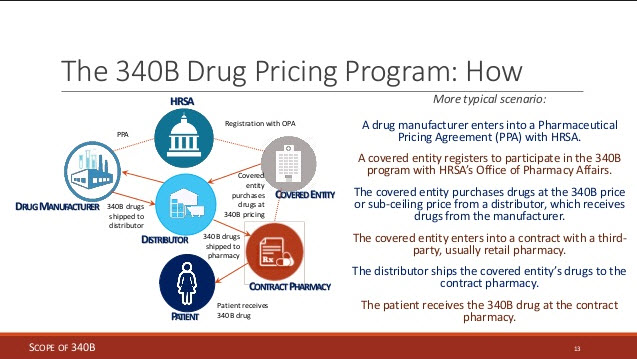Link to post on Substack (Link)
Diversion.
Diversion is a significant concern for manufacturers. Diversion is when a CE or a contracted pharmacy knowingly and intentionally resells or transfers a 340B drug to an ineligible patient.[1] Although the 340B statute prohibits diversion, diversion is still prevalent.[2] In 2020, the U.S. Government Accountability Office (“GAO”) conducted a series of audits that resulted in finding duplicate discounts in 35% of audits and 44% findings of diversion.[3]
Diversion risk is high when the dispensing entity has patients who are CE 340B eligible and patients who are not CE patients (thus not 340 eligible). HRSA guidance requires CE to track their inventory by physically separating the 340B discounted drugs from the rest of the inventory or through electronic record keeping.[4]
Why does diversion happen?
The reasons for diversion vary depending on perspective. Pharmaceutical manufacturers often attribute the prevalence of diversion to the profit-driven motives of covered entities (CEs) and the lack of enforcement from the HRSA.
The potential profit CEs can gain from the program explains the growth in the number of CEs participating in the 340B program and the volume of purchases of 340B discounted products. CEs can achieve greater profits if they expand the number of patients eligible for the program. Since CEOs are limited to dispensing only to their patients, they can use contract pharmacies—which dispense medications to a broader range of patient types—to benefit from the discounted drug program, even when the patient may not meet 340B eligibility criteria.[5]
Nearly half of audited covered entities unlawfully transferred or resold 340B drugs to non-eligible patients, with 66% of diversion cases tied to contract pharmacies.[6]
Covered entities may permit diversion in contract pharmacies to maximize revenue, as more prescriptions classified as 340B-eligible increase the spread between acquisition costs and insurance reimbursements. Contract pharmacies also benefit financially from diversion, as they often receive a percentage of the insurance reimbursement, enabling them to profit from improperly classified transactions.[7]
The substantial 340B profits of PBMs and pharmacy chains need more attention.
Not only do major pharmacy chains account for a significant portion of stand-alone pharmacies, but it is also common for PBMs to mandate that prescriptions be filled at their preferred pharmacies, particularly for specialty medications. While exact percentages of patients with plans requiring the PBM’s specialty pharmacy are challenging, the largest PBMs—such as CVS Caremark, OptumRx, and Express Scripts—collectively control approximately 79% of the U.S. pharmacy benefits market. [8] These PBMs represent a substantial share of patient lives. They mandate which pharmacies will fill the prescriptions and ultimately benefit from 340B profits.
Minnesota’s 340 B legislative report demonstrated major pharmacies/PBMs benefiting from the program. CE paid contract pharmacies and third-party administrators more than $120 million (representing CE’s paying $16 to external entities for every $100 of gross 340B revenue). [9]
PBMs benefit significantly from the 340B program through a per-prescription fee and/or percentage of the drug price. PBMs, insurers, and large pharmacy chains capture a substantial portion of 340B profits, diverting savings away from vulnerable patients who could benefit from reduced drug costs or improved care. This undermines the 340B program’s core purpose, shifting its benefits away from the patients and communities it was designed to serve.
[1] 42 U.S.C. § § 256b(d)(2)(B)(v)(I). 42 U.S.C. § 256b(a)(5)(B).
[2] For instance, out of 1,242 audits conducted by HRSA between 2012 and 2019, 546 cases involved findings of drug diversion, while 429 cases related to duplicate discounts involving the Medicaid program. See generally, Johnson & Johnson Health Care Systems Inc. v. Becerra, No. 1:24-cv-03188, 17-18, (D.D.C. filed Nov. 12, 2024), “For example, in 2020, the U.S. Government Accountability Office (“GAO”) found that, of 1,242 audits that HRSA conducted of covered entities from fiscal years 2012 through 2019, HRSA made 546 findings of diversion and 429 findings relating to duplicate discounts with the Medicaid program.” Id at 17-18 citing U.S. Gov’t Accountability Off., GAO-21-107, Drug Pricing Program: HHS Uses Multiple Mechanisms to Help Ensure Compliance with 340B Requirements 13 (Dec. 14, 2020), https://bit.ly/4dniPpD.
[3] U.S. Gov’t Accountability Off., GAO-21-107, Drug Pricing Program: HHS Uses Multiple Mechanisms to Help Ensure Compliance with 340B Requirements 13 (Dec. 14, 2020), https://bit.ly/4dniPpD.
[4] March 5, 2010 Federal Register Notice (75 Fed. Reg. 10272)
[5] “For oncology practices, one reason cited for the growth is the opportunity to expand the patient base for drugs purchased under the 340B discount drug purchase plan. The program allows facilities to purchase outpatient drugs at prices below market. Because the [Outpatient Prospective Payment System] payment rates for drugs furnished to hospital outpatients are the same for all hospitals without regard to whether the drugs were purchased through the 340B program, hospitals have an incentive to increase margins by expanding their patient base for chemotherapy administration.” B. Wynn, P. Hussey, and T. Ruder, Policy Options for Addressing Medicare Payment Differentials Across Ambulatory Settings, RAND Technical Report (Santa Monica, CA; RAND, 2011) [hereafter “RAND Study”]
[6] 2018 GAO REPORT, supra note 26, at 38, 42. In 2017, GAO audited 200 CEs, which only represented 1.6% of CEs (2018 GAO REPORT, supra note 26, at 15).
[7] Caryn Levite Marshall, Exacerbating Ambiguity: Why the Final 340B Administrative Dispute Resolution Rule Is a Distraction from Needed Reform, 53 Seton Hall L. Rev. 1743 (2023), https://scholarship.shu.edu/cgi/viewcontent.cgi?article=3559&context=shlr.
[8] Adam J. Fein, PBM-Owned Specialty Pharmacies Expand Their Role In—and Profits From—the 340B Program, DRUG CHANNELS (July 21, 2020), http://drugchannels.net /pbm-owned-specialty-pharmacies-expand.html.; Adam J. Fein, 340B Continues Its Unbridled Takeover of Pharmacies and PBMs, DRUG CHANNELS (June 15, 2021) [hereinafter 340B Continues Unbridled Takeover], supra note 84, https://www.drugchannels.net/2021/06/exclusive340b-continues-its-unbridled.html.
[9] See Minnesota Department of Health, 340B Covered Entity Report: Report to the Minnesota Legislature 4 (2024), https://www.health.state.mn.us/data/340b/docs/2024report.pdf.
